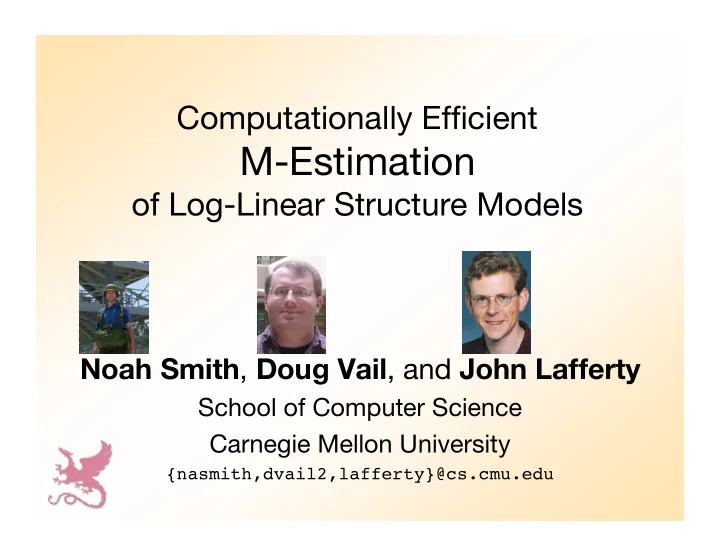

Computationally Efficient M-Estimation of Log-Linear Structure Models Noah Smith , Doug Vail , and John Lafferty School of Computer Science Carnegie Mellon University {nasmith,dvail2,lafferty}@cs.cmu.edu
Sketch of the Talk A new loss function for supervised structured classification with arbitrary features. • Fast & easy to train - no partition functions! • Consistent estimator of the joint distribution • Information-theoretic interpretation • Some practical issues • Speed & accuracy comparison
Log-Linear Models as Classifiers Distribution: in out partition function parameters dot-product Classification: score dynamic programming, search, discrete optimization, etc.
Training Log-Linear Models Maximum Likelihood Estimation: pain Also, discriminative alternatives: • conditional random fields ( x -wise partition functions) • maximum margin training (decoding during training)
Notational Variant “some other” distribution Still log-linear.
Jeon and Lin (2006) A new loss function for training: exponentiated, base negated dot- distribution product scores
Jeon and Lin (2006) A new loss function for training: exponentiated, base negated dot- distribution product scores
Attractive Properties of the M-Estimator Computationally efficient.
Attractive Properties of the M-Estimator Convex. exp is convex; affine composition → convex linear linear
Statistical Consistency • If the data were drawn from some distribution in the given family, parameterized by w * , then • True of MLE, Pseudolikelihood, and the M- estimator. – Conditional likelihood is consistent for the conditional distribution.
Information-Theoretic Interpretation • True model: p ? • Perturbation applied to p ? , resulting in q 0 • Goal: recover the true distribution by correcting the perturbation.
Information-Theoretic Interpretation • True model: p ? • Perturbation applied to p ? , resulting in q 0 • Goal: recover the true distribution by correcting the perturbation. MLE J&L’06
Minimizing KL Divergence
So far … • Alternative objective function for log-linear models. – Efficient to compute – Convex and differentiable – Easy to implement – Consistent • Interesting information-theoretic motivation. Next … • Practical issues • Experiments
q 0 Desiderata • Fast to estimate • Smooth • Straightforward calculation of E q 0 [f] Here: smoothed HMM. – See paper for details on E q 0 [f] - linear system! In general, can sample from q 0 to estimate.
Optimization Can use Quasi-Newton methods (L-BFGS, CG). The gradient:
Regularization Problem : If we estimate E q 0 [ f j ] = 0, then w j will tend toward - ∞ . Quadratic regularizer: Can be interpreted as a 0-mean, c -variance, diagonal Gaussian prior on w ; maximum a posteriori analog for the M-estimator.
Experiments • Data: CoNLL-2000 shallow parsing dataset • Task: NP-chunking (by B-I-O labeling) • Baseline/ q 0 : smoothed MLE trigram HMM; B-I-O label emits word and tag separately • Quadratic regularization for log-linear models, c selected on held-out.
B-I-O Example NNS IN NNS VB RB VBN JJR IN DT NNS B O B O O O O O B I Profits of franchises have n’t been higher since the mid-1970s
Experiments time precision recall F 1 (h:m:s) HMM 0:00:02 85.6 88.7 87.1 M-est. 1:01:37 88.9 90.4 89.6 MEMM 3:39:52 90.9 92.2 91.5 PL 9:34:52 91.9 91.8 91.8 CRF 64:18:24 94.0 93.7 93.9 rich features (Sha & Pereira ‘03)
Accuracy, Training Time, and c under-regularization hurts
Generative/Discriminative vs. Features more than additive
18 Minutes Are Not Enough • See the paper – q 0 experiments – negative result: attempt to “make it discriminative” • WSJ section 22 dependency parsing – generative baseline/ q 0 ( ≈ Klein & Manning ‘03) – 85.2% → 86.4% – 2 million → 3 million features ( ≈ McDonald et al. ‘05) – 4 hours training per value of c
Ongoing & Future Work • Discriminative training works better but takes longer. – Cases where discriminative training may be too expensive • high complexity inference (parsing) • n is very large (MT?) – Is there an efficient estimator like this for the conditional distribution? • Hidden variables increase complexity, too. – Use M-estimator for M step in EM? – Is there an efficient estimator like this that handles hidden variables?
Conclusion • M-estimation is accuracy – fast to train (no partition functions) – easy to implement – statistically consistent runtime – feature-empowered (like CRFs) – generative A new point on the spectrum of speed/ accuracy/expressiveness tradeoffs.
Thanks!
How important is the choice of q 0 ? • MAP-trained HMM • Empirical marginal: • Locally uniform model – Uniform transitions 4 out-arcs 4 out-arcs – No temporal effects B I – 0% precision, recall O 3 out-arcs
q 0 Experiments select c to F 1 precision recall q 0 maximize: baseline HMM (no M-est.) 85.6 88.7 87.1 88.9 90.4 89.6 HMM F 1 empirical F 1 84.4 89.4 86.8 marginal locally F 1 72.9 57.6 64.3 uniform precision 84.4 37.7 52.1 transitions
Negative Result: Input-Only Features Idea : Make M-estimator “more discriminative” by including features of words/tags only. • Think of the model in two parts: Improve fit here … … by doing more of the → Virtually no effect. “explanatory work” here.
Recommend
More recommend